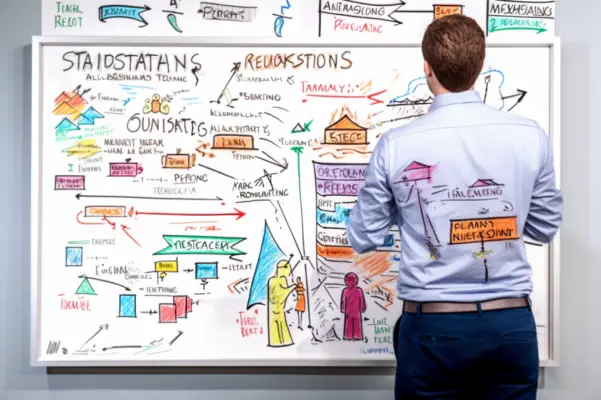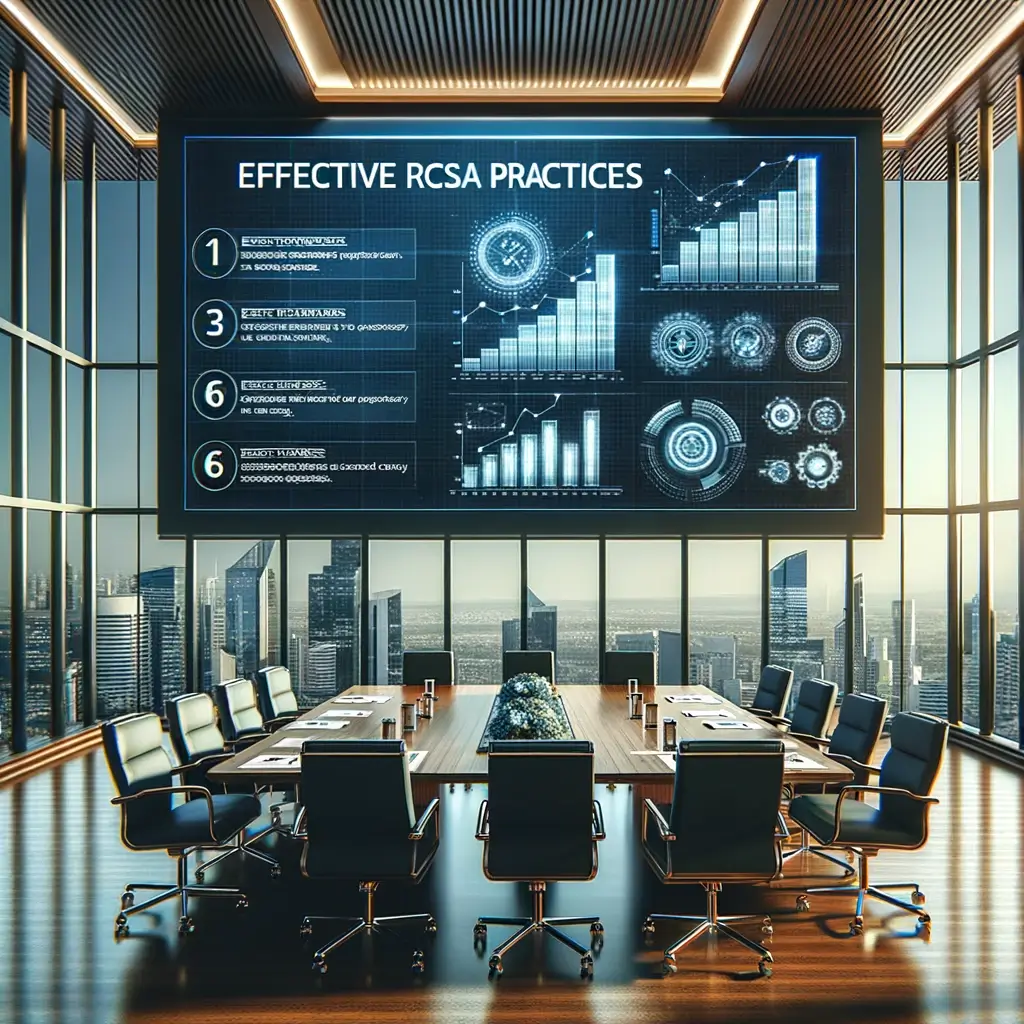In the ever-evolving business world, an organization’s ability to adeptly identify, evaluate, and manage risks is paramount. Particularly in the financial sector, Risk Control Self-Assessment (RCSA) serves as a cornerstone in establishing a robust, preventative risk management culture. The practices include:-
- Align RCSA with business strategy (source: MetricStream)
- Establish a dynamic, iterative process (source: MetricStream)
- Enable an integrated approach (source: MetricStream)
- Quantify risk in monetary terms (source: MetricStream)
- Foster a risk-aware culture, encourage open communication, and leverage technology for real-time monitoring (source: LinkedIn)
- Ensure any rating and/or rationale differences and unmitigated risks that are outside of the institution’s risk appetite have been addressed (source: Treliant)
This is not limited to compliance with regulations but also feeds into strategic decision-making. This article probes into the essence of RCSA, the building blocks of a sturdy RCSA framework, and the best practices in risk identification.
We delve into the critical facets of RCSA implementation and the importance of continuous improvement in maintaining an effective risk management process.
Understanding RCSA
The Risk Control Self-Assessment (RCSA)
The Risk Control Self-Assessment (RCSA) serves as an instrumental tool for many business organizations worldwide. The aim of this narrative is to delve into the requisites that constitute RCSA and shed light on its imperativeness in modern business operations.
Risk Control Self-Assessment is an enterprise-wide tool used for identifying and assessing risks from a subjective stance. It is a process that enables management and teams across the organization to evaluate risks and controls in their functional units, thereby leading to risk mitigation.
Integral to the RCSA is the identification, assessment, and mitigation of risks that may deter an organization’s operations, reputation, or overall survival.
Navigating through the financial landscapes and operational crossroads introduces an element of risk. The propensity for risks makes it crucial for businesses to have a preemptive strategy.
This is where Risk Control Self-Assessment comes into play. The essentials of the RCSA process entail the identification of inherent risks, assessment of controls, estimation of residual risks, and development of action plans for risk mitigation.
The reliable effectiveness of RCSA lies in its participatory approach. The process involves active participation and collaboration across departments, unifying staff, supervisors, managers, and executives in a common quest: to unlock, understand, and manage potential risks.
It engenders a robust risk culture within an organization, bringing about heightened awareness and a holistic understanding of risks among the workforce.
Risk Control Self-Assessment serves two vital purposes. One, it allows the development of risk profiles that aid organizations in elaborating and enhancing their strategic decisions.
Two, it heightens the strength of internal controls, reinforcing confidence among stakeholders, including investors, customers, and regulatory authorities.
Moreover, the RCSA process acts as a first line of defense in risk management strategy. It paves the way for continuous monitoring, measurement, and management of risks, thus adding a vital layer of robustness to the organizational business model.
In this era of rapid digital transformation and regulatory dynamism, a firm and flexible risk management approach such as RCSA is more than just a necessity; it’s a strategic imperative.
It reflects an organization’s commitment to operate within an established risk appetite, thereby enhancing its reputation, stakeholder confidence, operational efficiency, and economic stability.
As such, from an analytical viewpoint, it’s clear that Risk Control Self-Assessment contributes significantly to the intricate fabric of contemporary business operations.

Building a Robust RCSA Framework
Recognizing the unparalleled significance of RCSA in business operations, it becomes essential to meticulously articulate the critical elements that underpin the development of a robust RCSA framework.
Aside from understanding what RCSA is and how it functions, it is crucial to delve into the influential constituents that help shape a formidable RCSA protocol.
Risk Identification Techniques and Mechanisms
Risk identification, the first step in any RCSA process, is of utmost importance. To ensure that this process is effective, robust identification methods and mechanisms must be put into place.
This includes the use of cutting-edge technology and advanced methodologies that aid in identifying both inherent and residual risks, thereby enhancing the overall quality of risk mapping and assessments.
Employee Training and Culture
A successful RCSA framework is invariably predicated on an organization’s internal culture and the proficiency of its employees.
Companies should invest in continuous training to improve their employees’ risk perception and risk management capabilities. Simultaneously, fostering a culture that values good risk management practices is a vital aspect of a robust RCSA framework.
Precise Scoring Methodologies
The effectiveness of the RCSA process is heavily reliant on how accurately risks are scored and prioritized.
A robust RCSA framework should, therefore, contain a risk-scoring methodology that strategically mutually agrees on guidelines for scoring potential risks based on their severity and likelihood.
Technological Infrastructure
In the digital age, the role of technology cannot be understated. A robust RCSA framework embraces the use of sophisticated technological tools to enhance the accuracy and efficiency of risk assessments.
With the help of artificial intelligence and machine learning, among other emerging technologies, organizations can better identify, analyze, and quantify operational risks.
Continuous Review and Improvement
Lastly, it must be stressed that a stalwart RCSA framework is never static. It’s a fluid and continuously evolving aspect of an organization’s operational risk management plan that requires consistent review and enhancement.
Cultivating a sustainable feedback mechanism allows for constant adjustments and improvements, reinforcing the framework and keeping it relevant to changing regulatory landscapes and operational conditions.
Moreover, creating an environment conducive to open communication ensures valuable insights from different hierarchical levels within the organization, fostering collective involvement in risk management efforts and advancing the maturity of the RCSA framework.
Reviewing these critical elements affirms the intrinsic complexity and comprehensiveness imperative to developing a robust RCSA framework.
It underscores the necessity of a comprehensive approach that intertwines human capabilities, innovative methodologies, technological infrastructure, and a system for continuous refinement.
Ultimately, these collectively confer enterprises with substantial capabilities to forecast, evaluate, and mitigate operational risks effectively.

Best Practices in Risk Identification
Having delved into the essence of Risk Control Self-Assessment (RCSA), shifting to the more specific segment of risk identification and categorization is a logical progression.
Effective risk identification within the RCSA process is pivotally important and involves scientifically outlined techniques and mechanisms.
Untangling a labyrinth of risks necessitates a comprehensive platform where potential risks are not just identified but systematically placed into categories.
Risk categorization abbreviates complex infrastructures and allows for specific risks to be treated proactively. It brings standardization, structures risk profiles and facilitates focused discussions to develop appropriate risk responses.
Within RCSA, risk identification can be carried out through a multitude of techniques, such as brainstorming sessions, structured interviews, questionnaires, and reviews of historical data and incidents.
From a holistic viewpoint, it is crucial to incorporate all relevant perspectives to uncover the nooks and crannies of possible risks. Among these mechanisms, internal historical data can serve as a rich source for risk identification as past issues often presage future risks.
However, this entire process, starting from risk identification to its categorization, can never be fully realized without meticulous training of personnel and fostering a risk-aware culture within an organization.
It is to be remembered that barriers to risk identification often stem from the cultural and psychological biases of individuals involved in the process. Training employees to understand different types of risk, identifying warning signs, and communicating them effectively can dismantle these hurdles, making for a more robust RCSA process.
Moreover, adding scientific objectivity to the process demands the deployment of precise scoring methodologies. Ideally, each identified risk ought to be evaluated based on its likelihood of occurrence and severity of impact.
Implementing risk scoring mechanisms like Risk Matrix, Risk Quantification, or Analytical Hierarchy Process (AHP) set parameters for risk evaluation, making comparisons and categorization straightforward.
In the digitally forward world of the 21st century, another indispensable segment of RCSA is a robust technological infrastructure. Modern technology allows for the effective tracking, comparison, and efficient management of identified risks.
Risk management software, or more commonly, Governance Risk and Compliance (GRC) platforms, can create platforms for consistent risk identification, evaluation, and monitoring.
Lastly, an effective RCSA process should never be static. A continuous review and improvement mechanism is essential to keep the process adaptive and evolving.
Continual reassessment refines the identification and categorization strategies, thereby enhancing the overall RCSA process. Bottomline, it forms the cornerstone of an environment in which future risks can be better predicted, assessed, and ultimately, controlled.
Perfecting the art of risk identification and categorization within the RCSA process is akin to solving a jigsaw puzzle; it demands putting together several features like employee training, precise scoring methods, and technological mediums. With each fitting piece, the picture of a more resilient and better-controlled organizational operation comes to light.

RCSA Implementation
After a keen investigation and exploration into the Risk Control Self-Assessment (RCSA) process, the conversation naturally pivots towards its seamless implementation.
Several focal points come to the forefront when discussing effective RCSA execution to ensure it fulfils its overarching risk management objectives.
Embarking on this crucial phase of the risk management journey, risk identification techniques and mechanisms claim an essential spot on the agenda.
Impressive results stem from employing a comprehensive mix of risk identification techniques such as scenario analysis, SWOT analysis, process mapping, horizon scanning, and loss data analysis.
While the selection of techniques depends on the nature of a business entity, it is crucial to acknowledge that a hybrid approach often uncovers a more profound stratum of risks, hence ensuring a thorough risk assessment.
No assembly of self-assessment mechanisms can complete its role without well-trained employees ingrained with a risk-sensitive culture.
Employee’s abilities to identify and measure potential risks drastically impact the effectiveness of the RCSA process. The employees must undergo meticulous training sessions to empower them with the necessary risk awareness.
Furthermore, fostering an organizational culture that encourages open conversation about risk aids in bridging gaps between all layers of operations.
RCSA’s strength emanates from precise scoring methodologies. The choice of a scoring methodology, whether it’s a simple risk matrix or a more sophisticated method like quantitative risk analysis, must resonate with the risk landscape of the particular organization.
Harmonized models such as Risk Matrix, Risk Quantification, or the Analytical Hierarchy Process provide malleable, comprehensive, and yet simple systems for risk evaluation.
Technological infrastructure is the beating heart of modern RCSA strategies. Properly utilized technology, particularly Governance, Risk, and Compliance (GRC) platforms, can automate and streamline the RCSA process, leading to significant cost and time savings.
It provides a central repository for risk data, facilitates information sharing, improves risk visibility, and enhances the quality of risk management decisions.
The essence of a productive RCSA process lies embedded within the cycle of continuous review and improvement. Post-implementation, frequent audits need to be undertaken to ensure relevance and effectiveness.
RCSA is a fluid concept that necessitates regular updates to remain aligned with the shifting business strategies, ever-changing regulations, and evolving risk landscape.
Finally, yet importantly, the role of risk identification and categorization cannot be understated in predicting and controlling future risks.
A robust approach to these stages fosters the organization’s resilience to unpredicted threats, thus facilitating risk reduction and situational control.
Indeed, effectively implementing the RCSA process is a multifaceted endeavour that not only strengthens the organization’s risk management framework but significantly contributes to the decision-making process.
It encapsulates the synergy between risk identification techniques, employee culture, scoring methodologies, technological infrastructure, and the continuous improvement cycle.
As one delves deeper into the dovetail joints of risk management, it becomes clear that the RCSA process is a critical protective armor organizations wear to withstand operational turbulence.

Reviewing and Improving RCSA
Continual assessment and enhancement of the Risk Control Self-Assessment (RCSA) process require firms to look far beyond the original design and implementation of the process.
It begins with the sensory ability of the organization, that is, their risk identification techniques, which delve into the quagmires of uncertainty.
A plethora of mechanisms can be harnessed to unmask these hidden threats, such as brainstorming, structured interviews, questionnaires, and detailed analysis of historical data and incidents. Predicting and controlling future risks are owed to the diligence in identifying and categorizing these risks.
To complement these techniques, it is essential that organizations foster a risk-aware culture. This is achieved through comprehensive training and nudging employees towards proactive involvement in identifying and managing risks.
A risk-aware workforce is the lifeblood of a robust RCSA process, becoming the organization’s eyes and ears to the intricate web of risks.
The complexities of risk identification and management warrant the use of precise scoring methodologies. Approaches like the Risk Matrix, Risk Quantification, and the Analytical Hierarchy Process provide a structure for understanding and evaluating risks, ensuring no threat goes unnoticed or underestimated.
These methodologies serve as the organization’s brain, making sense of the multitude of identified risks.
Additionally, the technological infrastructure plays an imperative role. Governance, Risk, and Compliance (GRC) platforms leap onto the modern digital landscape providing automated solutions, thereby making the RCSA process more streamlined and efficient.
Utilizing such technology effectively in the organization’s nervous system is crucial to meeting the evolving nature of risks.
Finally, the heart of improving the RCSA process lies in its continuous review and improvement. This aspect of dynamic evaluation prevents stagnation, making room for adaptation and enhancement.
As risks evolve and regulations tighten, the RCSA process should likewise mature, evolving into an increasingly effective risk management tool.
It is the combination of advanced risk identification techniques, risk-aware culture, clear scoring methodologies, appropriate utilization of technology, and continuous review and improvement that will enable an organization to continually assess and enhance its RCSA process in line with evolving risks and regulations.

Conclusion
The facet of risk control is not a static, one-time implementation but rather a dynamic process subject to constant evolution and improvement.
Being mindful of a changing risk climate and ensuring the process aligns with current regulations is crucial. The implementation of Risk Control Self-Assessment (RCSA) does not bring an end to risk management.
Instead, it marks the beginning of a continual cycle of assessments, adjustments, and improvements. By embracing regular reviews and feedback mechanisms and updating the RCSA process, organizations can stay ahead in the game of risk management, reinforcing their resilience and proactivity.
After all, a successful risk management process is not about avoiding risk but about understanding, controlling, and effectively managing it.

Chris Ekai is a Risk Management expert with over 10 years of experience in the field. He has a Master’s(MSc) degree in Risk Management from University of Portsmouth and is a CPA and Finance professional. He currently works as a Content Manager at Risk Publishing, writing about Enterprise Risk Management, Business Continuity Management and Project Management.

